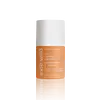What's inside
What's inside
 Key Ingredients
Key Ingredients

 Benefits
Benefits

 Concerns
Concerns

No concerns
 Ingredients Side-by-side
Ingredients Side-by-side

Water
Skin Conditioning3-O-Ethyl Ascorbic Acid
Skin ConditioningPropanediol
SolventNiacinamide
SmoothingGlycerin
HumectantPolyglyceryl-6 Caprylate
EmulsifyingPolyglyceryl-10 Laurate
Skin ConditioningPolyglyceryl-4 Caprate
EmulsifyingTocopheryl Acetate
AntioxidantHydroxyacetophenone
AntioxidantBisabolol
MaskingFerulic Acid
AntimicrobialPolyglyceryl-10 Myristate
Skin ConditioningXanthan Gum
EmulsifyingCaprylyl Glycol
EmollientWithania Somnifera Root Extract
Skin ConditioningCurcuma Longa Root Extract
MaskingSclerotium Gum
Emulsion StabilisingLecithin
EmollientPullulan
Sorbitol
Humectant1,2-Hexanediol
Skin ConditioningSilica
AbrasivePhenoxyethanol
PreservativeBiosaccharide Gum-4
Skin ConditioningPentylene Glycol
Skin ConditioningSodium Hyaluronate
HumectantScenedesmus Rubescens Extract
Skin ConditioningAscorbic Acid
AntioxidantCI 77480
Cosmetic ColorantCitric Acid
BufferingGlutathione
Water, 3-O-Ethyl Ascorbic Acid, Propanediol, Niacinamide, Glycerin, Polyglyceryl-6 Caprylate, Polyglyceryl-10 Laurate, Polyglyceryl-4 Caprate, Tocopheryl Acetate, Hydroxyacetophenone, Bisabolol, Ferulic Acid, Polyglyceryl-10 Myristate, Xanthan Gum, Caprylyl Glycol, Withania Somnifera Root Extract, Curcuma Longa Root Extract, Sclerotium Gum, Lecithin, Pullulan, Sorbitol, 1,2-Hexanediol, Silica, Phenoxyethanol, Biosaccharide Gum-4, Pentylene Glycol, Sodium Hyaluronate, Scenedesmus Rubescens Extract, Ascorbic Acid, CI 77480, Citric Acid, Glutathione
Ingredients Explained
These ingredients are found in both products.
Ingredients higher up in an ingredient list are typically present in a larger amount.
Ascorbic Acid is is pure Vitamin C. This form makes up the largest amount of vitamin C found naturally in our skin.
Not only is vitamin C great for your overall health and immune system, it also has plenty of benefits on your skin.
Vitamin C is best used for brightening skin. It improves dark spots, acne scars, and hyperpigmentation. This is because it blocks the process of skin darkening when exposed to UV.
Remember: Vitamin C should not replace sunscreen!
Your skin uses vitamin C to build collagen. Collagen is one key component in having a strong skin barrier and plump skin. Vitamin C also plays a role in regulating collagen, thus making it effective in improving wrinkles and fine lines.
Ascorbic acid shows potent antioxidant activity. As an antioxidant, it helps fight free-radicals. Free-radicals are molecules that may damage your skin cells. These antioxidants also protect skin against UV damage.
The best formulations include Vitamin E and/or ferulic acid. These two ingredients help stabilize and provide a boost in the benefits of ascorbic acid. This is because ascorbic acid becomes unstable when exposed to UV and air. In fact, you can tell your ascorbic acid has oxidized when it turns an orange-yellow color.
Ascorbic acid is generally compatible with other ingredients. However, using ascorbic acid with other active ingredients might cause irritation. Two ingredients: copper ions and benzoyl peroxide, will inactivate ascorbic acid completely.
Read more about other types of Vitamin C:
Foods rich with vitamin C include oranges, strawberries, broccoli, bell peppers, and more. When consuming Vitamin C, your skin receives a portion of the nutrients.
Learn more about Ascorbic AcidGlycerin is already naturally found in your skin. It helps moisturize and protect your skin.
A study from 2016 found glycerin to be more effective as a humectant than AHAs and hyaluronic acid.
As a humectant, it helps the skin stay hydrated by pulling moisture to your skin. The low molecular weight of glycerin allows it to pull moisture into the deeper layers of your skin.
Hydrated skin improves your skin barrier; Your skin barrier helps protect against irritants and bacteria.
Glycerin has also been found to have antimicrobial and antiviral properties. Due to these properties, glycerin is often used in wound and burn treatments.
In cosmetics, glycerin is usually derived from plants such as soybean or palm. However, it can also be sourced from animals, such as tallow or animal fat.
This ingredient is organic, colorless, odorless, and non-toxic.
Glycerin is the name for this ingredient in American English. British English uses Glycerol/Glycerine.
Learn more about GlycerinPhenoxyethanol is a preservative that has germicide, antimicrobial, and aromatic properties. Studies show that phenoxyethanol can prevent microbial growth. By itself, it has a scent that is similar to that of a rose.
It's often used in formulations along with Caprylyl Glycol to preserve the shelf life of products.
Propanediol is an all-star ingredient. It softens, hydrates, and smooths the skin.
It’s often used to:
Propanediol is not likely to cause sensitivity and considered safe to use. It is derived from corn or petroleum with a clear color and no scent.
Learn more about PropanediolSodium Hyaluronate is hyaluronic acid's salt form. It is commonly derived from the sodium salt of hyaluronic acid.
Like hyaluronic acid, it is great at holding water and acts as a humectant. This makes it a great skin hydrating ingredient.
Sodium Hyaluronate is naturally occurring in our bodies and is mostly found in eye fluid and joints.
These are some other common types of Hyaluronic Acid:
Learn more about Sodium HyaluronateWater. It's the most common cosmetic ingredient of all. You'll usually see it at the top of ingredient lists, meaning that it makes up the largest part of the product.
So why is it so popular? Water most often acts as a solvent - this means that it helps dissolve other ingredients into the formulation.
You'll also recognize water as that liquid we all need to stay alive. If you see this, drink a glass of water. Stay hydrated!
Learn more about Water